| Pat Scannon has been involved with WWII history,
wrecks, exploration on the islands of Palau. He is also the founder of Bent Prop that became Project Recover,
and self funded "PMAN" (Palau-Marines+Army
Air Force+Navy) expeditions to the Palau area in search of history.
His work and discoveries since 1993 include: finding a Japanese
armed trawler reportedly sunk by George H. W. Bush, plus many other significant
ship and aircraft wrecks and MIA cases in the Palau area.
Tell a little about yourself and your background
Born in Fort Knox KY and as an Army brat
of an officer, traveled a lot courtesy of the US Army. Lived in many
states and Germany - graduated from the University of Georgia with
a BSChem degree ('69), then a PhD from UC Berkeley ('72), then an
MD from the Medical College of Georgia ('76), then board certified
in Internal Medicine ('79).
After spending two years at the Letterman Army
Institute of Research in San Francisco (as a major in the Army Medical
Corps, '79-'80), instead of joining a private practice, I started
a biotech company specializing in therapeutics in '80 (XOMA, Ltd)
and am its Chief Scientific and Medical Officer. I am married (Susan) and have one daughter (Nell).
Susan and I live in San Francisco, CA and my daughter has graduated
from college and works in Sacramento, CA.
Speak about your interest in the Pacific
I have always had an interest concerning WWII,
probably through both my mother and father, but mostly in Europe.
As well, I have had a life long interest in aviation. In 1993, my wife, Susan and I were invited by Dan
Bailey (Author, WWII Wrecks of Palau) and Chip
Lambert (located USS Mississinewa wreck) to become part of a
dive team in Palau to search for a Japanese trawler sunk by George
H. W. Bush in July 1944. The government of Palau was interested in
finding this site as part of their 50-year remembrance of the Peleliu
invasion, planned for September 1994.
We did find this ship wreck and
documented it. The President of Palau recognized our work and authorized
a press release upon our discovery. In addition, our underwater
video footage, much to our amazement, appeared on Nightline nationwide
as proof that then-Ensign Bush had in fact sunk an armed trawler,
as opposed to an unarmed one (which had become a brief controversy
in 1994 during and after the US Presidential election).
My wife and I stayed on in Palau after the dive
team left and we hired a guide to take us to "other wrecks".
Instead of taking us to well-known ship wrecks, he took us to a
65 foot aircraft wing with two engine mounts. He did not know anything
about it. But he did know there were other airplane wrecks "all
over the place". I determined that the wing was American and
became captivated with wanting to know what happened to the crew
of this plane as well as all the others that might be around this
area. I started doing research as soon as I got back to the US
and quickly learned that many US aircraft remain missing within
the scuba-divable Palauan barrier reef system (an important delineation
as the ocean depths exceed 5000 feet outside).
My research of records (USN, USMC, USAF, National
Archives, and more) to date (which involves nine years of discovery)
indicates that within (or very nearby) the Palau barrier reef, at
least 79 US aircraft crashed as a result of combat (most to very
intense AAA fire), of which 58 have not yet been found (of which
31 aircraft are known to contain/be associated with at least 55
MIA's).
Of the 21 US aircraft found to date, 5 were found
by others over the years and 16 have been found by our efforts.
10 of these 16 found aircraft are associated with known OR possible
MIA's ( we are still investigating ALL of them).
The remaining 6 of the 16 are wreck sites from
which remains were recovered after the war or from which the airmen
survived. This does not include several Japanese aircraft also found
by us and others over the years.
I came back to Palau alone in '94 and '95 and,
working with local guides, found a number of additional crash sites.
So much exploration is involved that I started bringing teams with
me in '96.
Chip and Pam Lambert have traveled with me on expeditions in '96, '99, and '00 (not including
my participation in Chip's expedition to Ulithi in '01 to find the
sunken USS Mississinewa - this adventure can be separately found on BentProp.org.
Dan Bailey, who has located so many ship wrecks in Palau, Truk and
Kwaj, also traveled with me at least once ('99).
Starting in '01, a video team headed by Dan O'Brien
and Jennifer Powers (PostStar Productions) has accompanied me on
my last two expeditions in Palau ('01, '02) to create a documentary
about these efforts (Last Flight Home).
Starting in '99, as a member of the Explorers Club,
I also have had the honor of being selected to carry an Explorers
Club flag with me to document these later expeditions ('99, '00,
'01, '02).
Explain the mission of Bentprop.org
The BentProp Project is a formalization
that I felt was needed to further the earlier efforts. The purposes
for creating the BentProp Project, started in '00, include:
1) Dissemination of our expeditionary findings
(since '99, each expedition has been given a PMAN numerical designation
- for Palau-Marines+Army Air Force+Navy) through our website, BentProp.org (many thanks to our web master, Reid Joyce).
2) Creation of a record which will add to
the known history in Palau of the sacrifices made by Americans in
defense of our country during WWII (I write up and share each expediton's
findings, as appropriate, with the Navy Historical Center, the Air
Force Historical Research Center, the Marine Corps Historical Center,
the US Army Central identification Laboratory, Hawaii (CILHI / JPAC) and
the Palau Historical Presrvation Office, as well as others.
3) Education for interested people in the
air campaigns fought over Palau from MAR 1944 to war's.
4) Education about the aircraft involved
in these campaigns. (NOTE: our latest effort on the web site is
the addition of a "can you identify this airplane?" section
where we show parts we have found but not yet identified. Now website
visitors can get involved without going to Palau!).
Since 1996, I have gone to Palau with select teams,
with each member having one or more specialties, according to the
mission. For example, we have used underwater magnetometry, with
the help of a Stanford University professor, Dr. Greg Kovacs and
his computer expert father-in-law, Reid Joyce to try to find aircraft
in the ocean. On our last expedition, we had aviation experts along,
like Val Thal-Slocum and Flip Colmer to help as we discover new
sites. One of our plans on the drawing board is a formal mapping
project for all crash sites we have found in Palau and, for that,
we have identified a mapping expert to assist in cataloging all
the sites (which we always try to document where possible with GPS).
One amazing footnote: throughout the entire nine
years to date, all of this exploration has been self-funded by the
individual team members. Everyone has paid their own expenses without
the help of outside sources. While this has given us enormous flexibility
- a major benefit thus far, it is also worth saying that every member's
involvement has been a true labor of love: once in Palau, we work
very hard from dawn into the night regardless of weather,in the
jungles or in the water - and almost never have time for anything
else, including the incredible recreational diving available in
Palau.
Please share about your work with MIA Cases
There are three types of crash sites within
Palau:
1) those associated with airmen who were
rescued,
2) those associated with airmen who were
KIA and their remains were recovered and
3) those associated with MIA's. It turns
out that of the MIA's still missing, we have discovered relatively
recently that some of these airmen were captured and most probably
executed - I am still working on figuring out just how many. So
in addition to searching for crash sites, I am also working on trying
to determine what happened to certain MIA's who we now suspect may
have been captured and executed.
B-24M "Brief" 44-42058 navigator, Lt Wallace Kaufman, is known
to have been captured and beheaded in May 1945 (in '01, working with
Professor Donald Shuster and his wife at the University of Guam,
we located his executioner in Japan and I was able to interview
him there - quite an experience). Due to the relentless work of
my friend and colleague, Professor Shuster, we know at least three
other US airmen (and 10 missionaries) were also captured and executed.
This has stimulated me to review yet other records - I now am convinced
that other Americans were executed in Palau as well. None of these
executed airmen's remains, except for LT Kaufman, have yet been
found.
Through my contact with Professor Shuster, in '00
I started working with US Army's
CILHI, a truly incredible organization dedicated to finding
and identifying our military MIA's. CILHI has sent two expedition
teams to Palau in association with our efforts ('00,'01) and one
of their senior forensic anthropologists, Dr. William Belcher, has
accompanied us on our last expedition in '02. Because the scope
of CILHI's efforts are so vast (searching for ~90,000 remaining
MIA's - of which ~ 80,000 are from WWII), they cannot be everywhere.
CILHI and I have been working together closely and they have graciously
helped, where they could, to provide information to me, as well
as to educate us so that that our methods of discovery are compatible
with accepted archeological practice (and since these sites are
all over 50 years old, by definition, they are all archelogical
sites). In turn, I keep CIHI informed through formal reports of
all our findings. This type of cooperation I understand is somewhat
unique but has worked very well. I like to think we are helping
to extend CILHI's search for MIA's.
Speak about a few sites
that are memorable to you
Several of the searches have been very special for me.
As examples only, I found a Corsair deep in a mangrove swamp in
'94 and after a good dose of luck and elbow grease was able to locate
four years later the aviator who flew it. Walter Brown, and his
wonderful wife Frances, have become dear friends. As a result, I
also met his former squadron commander, Walter Meyer, whom I also
consider a close friend.
Another Corsair that I have not yet found was flown
by MAJ Quintus B. Nelson, squadron commander of VMF-122 - but in
the process, too long to describe here, I have met his only child,
his son, Jim, who has gone to Palau with me in search of his still
missing father. Our trip together last April is something our entire
team will never forget (see PMANIV report on web site).
I have gotten to know the reunion group historians,
people like Bill Cantrell (VMF-114) and Jim Kendall (307th BG(H))
- each of whom can go on for hours about their unit's involvement
in WWI (and happily they have done so with me).
Then there is the TBM Avenger we found on PMANIII
('01) piloted by MAJ Harry Scullin. Since '00, I have carried American
flags with me to include in ceremonies as we find aircraft. After
the ceremony, I deliver the flags to family members, along with
photos and videos, as we locate the family members. For MAJ Scullin's
ceremony I had two such flags, one for each of his surviving sisters,
who had never been able to find out anything about their brother's
death. Members of the PMAN team delivered the flags, along with
me, to the two sisters, this past September in St Louis - again
something very, very special. There are simple too many of these
stories.
What part do veterans play in your research?
Four sources of information have proven
invaluable thus far in our searches: 1) the official records (which
provide aircraft and personnel details but typically, due to the "fog of war",
lack substance as to location), 2) Palauan elders and chiefs who
actually witnessed some of the aircraft crash, 3) regional Palauan
hunter/fisher guides who find crash sites as part of their livelihood
- I have established a network of such guides throughout Palau,
and 4) veterans who flew these missions.
In addition to the three fast carrier attacks in
Palau, involving many Navy squadrons, seven other units played important
roles in the air campaigns over Palau: VMF (Marine Fighter Squadron)-114,
VMF-122, VMF-121, VMTB (Marine Torpedo Squadron)-134, 307th BG of the 13th AF, 494th
BG of the 7th AAF and the 90th BG of the 5th AF. I have spoken
with many veterans from every one of these groups and have had the
privilege of presenting our findings to reunion groups associated
with most of these groups.
I have found their recollections very useful in
the searches and particularly of value for relating stories about
their lost comrades over Palau. They have allowed me to copy literally
many hundreds of photographs from Palau taken during WWII, otherwise
unobtainable. This group of men, as well as their families, provide
not just information - they are a profound reminder of what it has
taken (and will continue to take) to protect our country and its
freedoms.
What do you think should be done with
wreck sites?
Actually, the decision as to what happens
to these sites is out of my hands - these are all archeological
sites, protected by US and Palauan law. Further, all Navy/Marine
sites by US Navy policy remain the property of the US Navy. Scavenging
or salvaging these historical sites is forbidden and I absolutely
agree with these policies. In certain rare instances, credible museums
may make a case for preservation but they will need to persuade
multiple US and Palauan agencies, as well as local chiefs, to be
able to do so. In fact, I have been asked by both US and Palauan
officials NOT to publish GPS coordinates of any site we find. We
continue to honor those requests.
Thank you for the interview, Dr. Scannon |
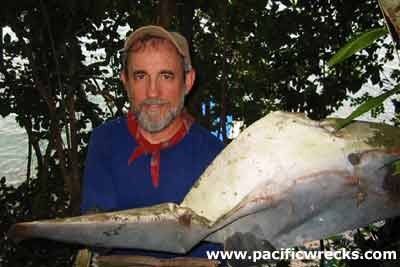
Pat Scannon, 2002

Ens
George H W Bush in TBF

Pat
Scannon and Pam Lambert on Japanese armed trawler sunk by George H. Bush in
Palau
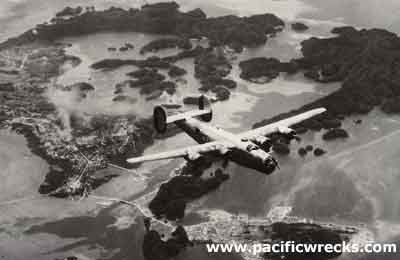
307th BG B-24 over Koror
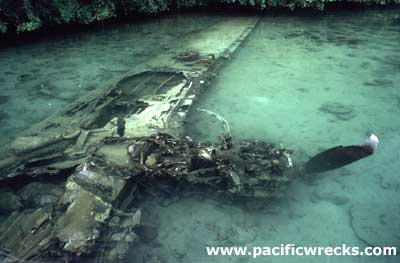
B-24J 44-40603 wing
lost over
Koror

Mission
Photograph showing both the port wing and fuselage of B-24 ‘603
in terminal flight
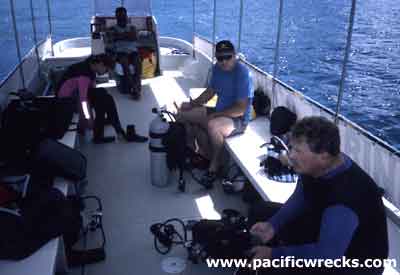
PMANI
Team on Dive Boat near southern Babeldaob searching for B-24J ‘453,
1999
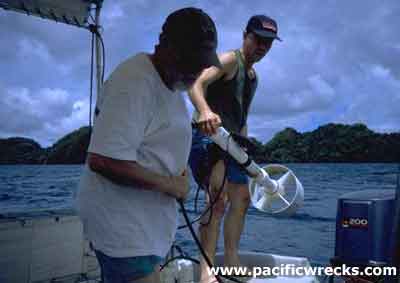
Prep magnetometer
into water near southern Babeldaob looking for B-24J ‘453
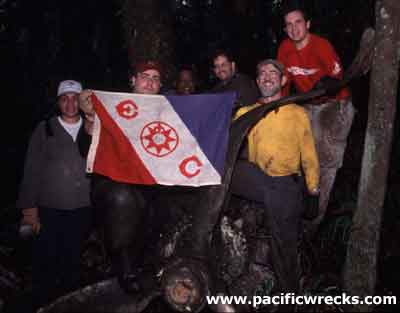
TBM Avenger, 45946 November 2001
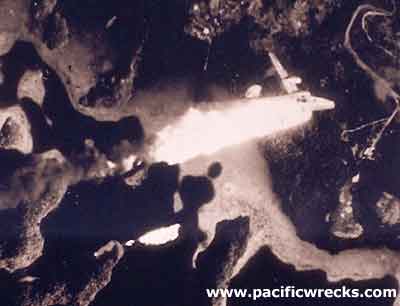
B-24M “Brief" 44-42058
lost over Koror

Dr.
Bill Belcher with identifying panel from F4U 57807,
lost 10MAR45, Babeldaob, 2002
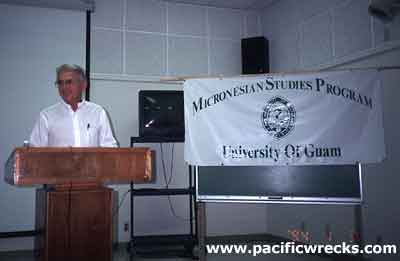
Professor Donald Shuster
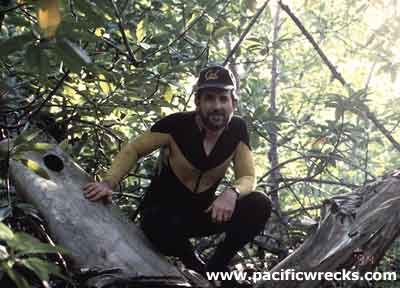
Pat
Scannon on F4U 14257 in mangrove swamp in northern
Koror, from which LT W. Brown bailed and survived, 04MAR45
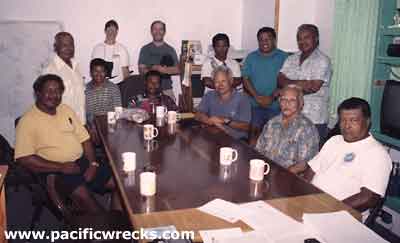
Pam Lambert and Pat Scannon with Ngatpang chiefs in search of Japanese
jungle HQ in Palau

Pat Scannon and Bill Cantrell, LTC (ret), USMC on Peleliu

Members of PMANIV team with American flags at crash site of TBF Avenger 45946
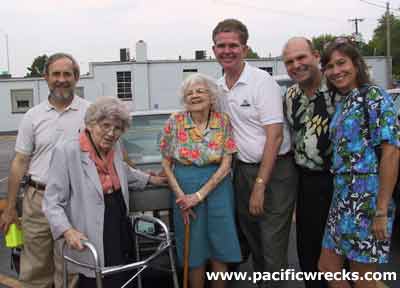
Delivering American flags from Scullin's TBF Avenger 45946 to his two sisters, November 2001
|